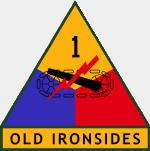Hobby Master HG4213 US Willys Jeep with 37mm Anti-Tank Gun - 3rd Battalion, 1st Armored Regiment, 1st Armored Division, Tunisia, 1943 (1:72 Scale)
"In war there is no second prize for the runner-up."
- General Omar Bradley
 Developed by the Quartermaster Corps, the jeep and other motor transport vehicles were transferred to the Ordnance Department in August 1942. Despite its lightweight, the jeep could perform a variety of functions, including towing a 37mm antitank gun over a 7% grade. Unencumbered, the jeep could climb a 60% grade, and was capable of attaining speeds in excess of 60-mph on a level highway. It could ford a stream 18-inches deep, even when fully equipped and loaded. It had a cruising range of approximately 300 miles on 15 gallons of gasoline. Operated by a crew of two, the jeep had a space in the rear for equipment or additional personnel.
Developed by the Quartermaster Corps, the jeep and other motor transport vehicles were transferred to the Ordnance Department in August 1942. Despite its lightweight, the jeep could perform a variety of functions, including towing a 37mm antitank gun over a 7% grade. Unencumbered, the jeep could climb a 60% grade, and was capable of attaining speeds in excess of 60-mph on a level highway. It could ford a stream 18-inches deep, even when fully equipped and loaded. It had a cruising range of approximately 300 miles on 15 gallons of gasoline. Operated by a crew of two, the jeep had a space in the rear for equipment or additional personnel.
Pictured here is a 1:72 scale replica of a US Willys Jeep with a 37mm anti-tank tun that was attached to the 3rd Battalion, 1st Armored Regiment, 1st Armored Division, then deployed to Tunisia during 1943.
Sold Out!
Dimensions:
Length: 2-1/2-inches
Width: 1-1/4-inches
Release Date: February 2018
 Historical Account: "Baptism of Fire" - The Battle of Sidi Bou Zid was a World War II battle that took place during the larger Battle of Tunisia, fought between the 10. and the 21.Panzer Divisions under Hans-Jurgen von Arnim and the American 1st Armored Division under General Lloyd Fredendall in northeast Tunisia near Tunis.
Historical Account: "Baptism of Fire" - The Battle of Sidi Bou Zid was a World War II battle that took place during the larger Battle of Tunisia, fought between the 10. and the 21.Panzer Divisions under Hans-Jurgen von Arnim and the American 1st Armored Division under General Lloyd Fredendall in northeast Tunisia near Tunis.
Since November 1942, the area surrounding Sidi Bou Zid had been under the control of the Allied forces. On January 1943, Axis forces under commands of both Rommel (also known as Desert Fox) and Hans-Jurgen von Arnim were still concentrated and defending the Mareth Line, originally a French fortification near the coastal town of Medenine in southern Tunisia which was occupied by the Germans after Operation Capri.
At this point most of Tunisia was now in German hands especially after taking the Faad Pass from its French defenders on January 30th.
At 4 A.M. on February 14th, the German tanks, under the leadership of Lieutenant General Heinz Ziegler, the deputy to Arnim, surrounded two U.S. infantry battalions through Faad and Maizila passes, sites that General Dwight D. Eisenhower himself had inspected three hours earlier. The American task force was led by Lloyd Fredendall, a much criticized commander who neither visited the front nor considered input from commanders farther forward. He was settled in Tebessa 80 miles away from the battlefield.
The Germans drove off an American armored counterattack using more than 80 Panzer IV, Panzer III and Tiger II tanks. The attack started with an advance of tanks belonging to the 10.Panzer Division under the cover of a sandstorm. The 1st Armored Division troops tried to delay the German advance by firing a 105-mm. M101 howitzer semi-fixed ammunition installed in a M4 Sherman tank. This tactical move was in vain as they were shelled by German 8.8 cm KwK 43 anti-tank guns. In parallel, the 21.Panzer Division started hitting the 168th Infantry's 3rd Battalion positions on Djebel Ksiara (hill). Under heavy shelling, Colonel Thomas Drake leading 1,900 men of his 3rd Battalion requested permission to retreat. This request was denied by Fredendall who ordered them to hold their positions and wait for reinforcements until the help arrived. This never happened.
In fact, under the weak command of Lloyd Fredendall, U.S. infantry were scattered between two distant hills Djebel Lessouda and Djebel Ksiara where mutual support was very difficult. The Germans handled the battle with ease and with heavy losses before US withdrawal on February 17th. After being rescued by General Patton's son-in-law, Lieutenant Colonel John K. Waters, who was held as POW at OFLAG XIII-B camp, many US infantrymen would later join others on February 19th to fight the Battle of the Kasserine Pass.


